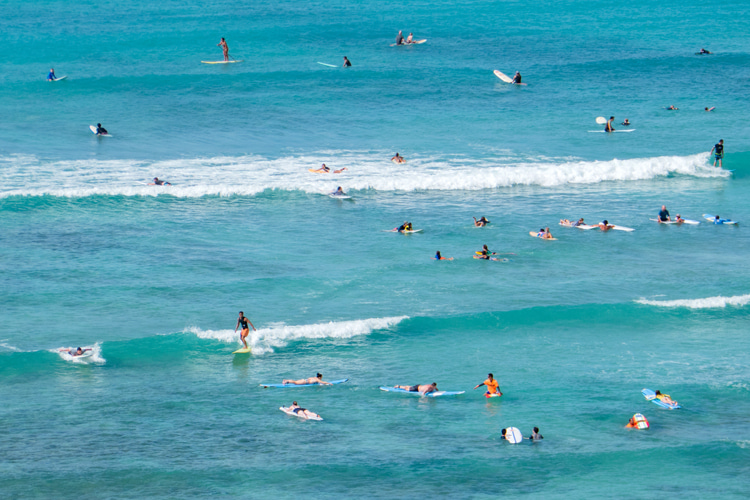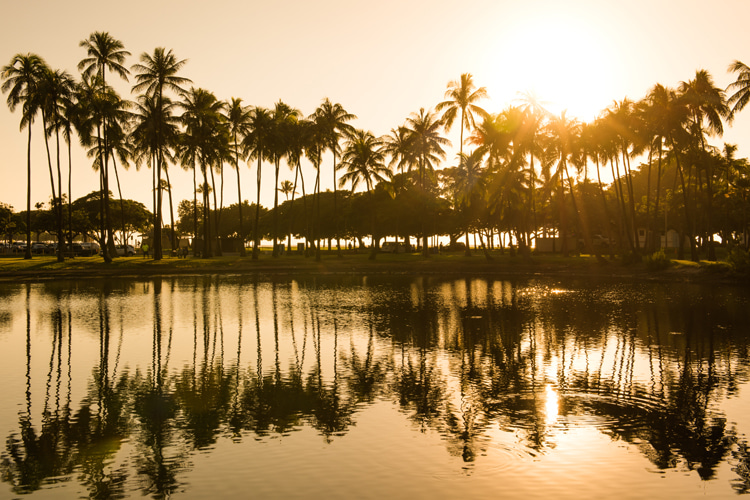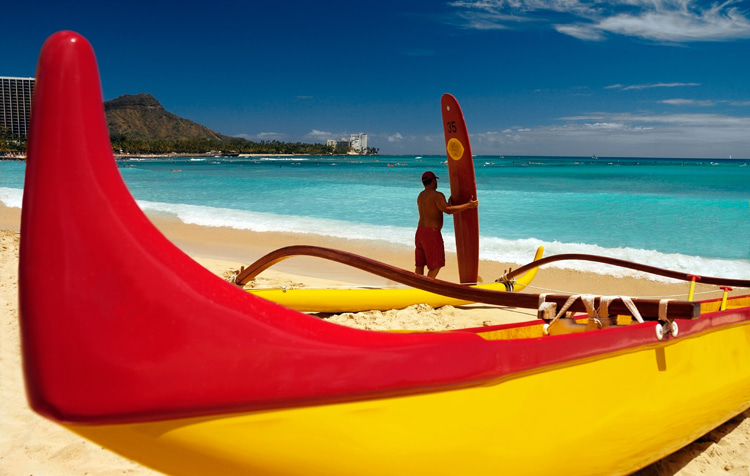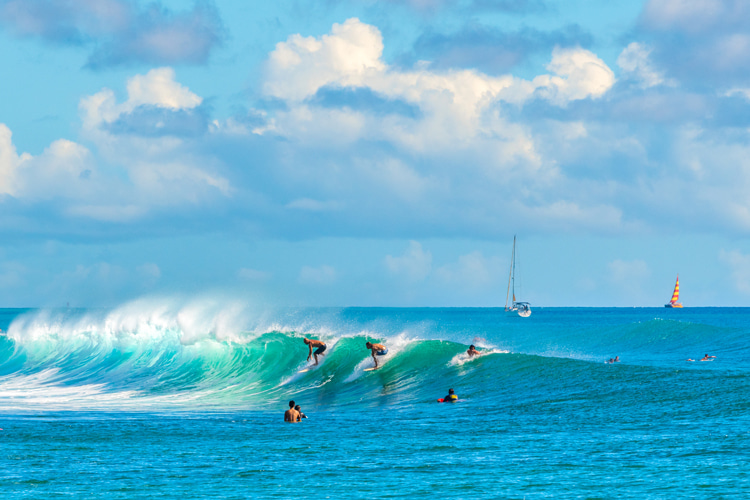I arrived back in Hawaii in May 1960, under entirely different conditions, together with my friend, Raphael Soriano, the noted California architect, who was looking into the potential of erecting some of his beautiful steel houses on the Islands.
I was shocked at what I saw.
The developers had gotten their hooks into Waikiki, and the tract builders were spreading their litter, amoeba-like, over the lovely hills and dales of the southern coast.
At this rate, it is only a matter of time until the Islands are one continuous tract, I thought.
Later, I wrote some articles on planning for the Honolulu Advertiser.
These articles, as well as stimulating belated Island-wide interest in planning, from the governor down, had at least one other unusual consequence.
Shortly after they had come out, I got a phone call from a gentleman whose momentary state I can only describe as exuberant.
I soon recognized the voice as belonging to Doug Simpson, an architect friend from Vancouver.
"Dismal Manurehead," he said belligerently.
"What did you say?"
"Well, if it isn't old Dismal!"
"I've come 3,000 miles especially to get away from you, and I open the paper, and what do I see but your fat old face staring out at me."
"I've rung up the paper and told them I'd cancel my subscription if they frighten me like that again."
My Vancouver office had just finished laying out the gardens of the Bayshore Inn, which Doug had designed.
He was in Hawaii on his annual luau. A few minutes later, feeling forced to accept his invitation, I joined the party.
Unfortunately, it is not easy to worry for long about anything in Hawaii; there are so many distractions.

Back to the Waves
After we had checked into the hotel, I repaired immediately to the beach.
I was delighted to find that Gilbert was still there, so I hired a surfboard from his charming wife Florence (she gave me a complimentary ticket!) and was quickly into the warm water, surrounded by the romance of what will ever be, to me, the world's loveliest beach.
Oh, oh, what had happened to those muscles over the last five years?
I paddled out to the place where the surf was building up on my rented board that wobbled excitedly with every stroke I took, turned her around, and took a few feeble strokes in an attempt to catch a wave.
I didn't make it, and in five minutes more, I was too exhausted to move.
Ninety percent of the people who take up surfing give it up after the first day's paddling, and now I could understand why.
I returned to the beach disgruntled and tried again two or three times that month, whenever I had time, with equally unsuccessful results, while out toward the buoy, I could see several surfers nonchalantly hotdogging down the waves, which are at their best in spring and summer in Waikiki.
I'll never get out there, I thought, not in a million years.
During June, I began a job that was to occupy my time on and off for the next eighteen months.
My firm was retained by Henry Kaiser as the chief design planner for Hawaii Kai, his new city near Honolulu, and all I managed until the end of the summer was an occasional swim in the sea since we were under constant pressure to produce results.
I believe during that time that I became the world's fastest city planner, but that, too, is another story.
Toward the end of the year, I was feeling in pretty bad shape since, in my profession, which is very complicated, you have to move around a lot.
The peripatetic planner finds little time for exercise, and if he does indulge and recovers, he is likely to retire to the nearest bar afterward to nurse his aching muscles and to put further strain on his straining belt.

Larry and George Segedin
It was at some time during this period that I made a statement that was to change my whole way of life.
I was having breakfast with two friends, Larry and George Segedin from New Jersey, when I happened to mention that I liked to surf.
Now Larry and George were both strapping six-footers, somewhat younger than I was.
Later I found out that they were stunned that anyone with a sagging stomach (since gone), who panted for breath as he tottered to his car, could even consider an energetic pastime like surfing.
If I could, so could they!
Larry was an architect, and George, a civil engineer. They were both natural enthusiasts and did things methodically and systematically by instinct.
A month later, I found out that every day at 6:30 in the morning, they were taking off down to Waikiki to surf.
They hired boards by the week since they were only using them in the early morning for the modest sum of $7.
This hire was sacrilegiously performed from Gilbert's fiercest competition, Barry Napoleon, a large, amiable, and handsome Hawaiian who, like Gilbert, came from a family of Island sportsmen.
Unfortunately, Gilbert didn't open until 8 a.m., so it was with some reluctance that I made the same arrangement as my friends, knowing that soon I would have to face a passionate Gilbert, stung by my betrayal and bitter in his denunciation.
It is a very good idea to try out a large number of different boards, as I will attempt to show later. In this way, you can more easily find the type that you like best before you buy one.
From then on, for the next nine months, I surfed at least twice a week with only a few gaps. Sometimes it would be five or six times a week, sometimes twice a day on weekends.
Throughout this period, those stalwart athletes, Larry and George, seldom missed a single day and would often spend an hour running at the Y.M.C.A. as well.
They ate healthy foods, too, although, fortunately, they were not by any means fanatical about it. It was hard to resist kidding them by asking them how the alfalfa tasted for dinner.
Healthy Body and Surf Knowledge
Frankly, if you want to surf, you have to get in shape and be sensible about your physical condition for, unless you are already fit when you start, you may need two or three months of regular exercise to build up your muscles and conditioning to the point where you can spend a couple of hours with the waves without becoming completely exhausted.
You have to be strong to surf, and conversely, if you can surf, you will be both strong and healthy; I'm certain that if everybody used a paddleboard twice a week, many doctors would be put out of business.
If you are already in lousy condition, there's no need to panic, however, since paddling alone will make you fit.
I have known good surfers who did not start till their 50s or 60s and am convinced that anyone who can weather the first week will soon get in shape, for I know of no other sport which will build your strength so quickly or so permanently.
And being superbly fit from your 30s on is the finest feeling on earth.
As you become more familiar with Waikiki, you realize that it looks quite different to a surfer than to an ordinary visitor.
To begin with, you only observe the obvious, such as the blueness of the water and its year-round average temperature of 78 degrees.
Later, on my frequent visits with Larry and George, I found that many things which had been, to say the least, obscure began to make more sense.
What had first appeared an irregular assortment of broken and unbroken waves designed mainly to part board and surfer as frequently as possible unfolded into a discernable pattern of definite wave formations.
At this point, rather than devoting a whole chapter to the surf at Waikiki, I will try to dovetail the descriptions of the different surfs to correspond with our appropriate stage of surfing prowess and so avoid breaking the narrative.

Canoes, Poplars and Queens
If you stand at one of the upper windows of the Moana Hotel, you will soon see that there are three main areas that are regularly used for surfing.
The first and most important of these is the popular Canoes which is directly in front of the hotel. This is used mostly by beginners and better surfers when the other surf is not up.
The second area is farther out in front of the Royal and the Halekulani and contains the slightly more difficult Poplars.
The third area to the east of Canoes is known as Queens.
When the surf is up, the larger First Break, Public Baths, Elks Club, and Castles may be running.
These surfs, which are ridden by experienced surfers, are described in Chapter IX.
The island of Oahu always has surf of some kind on one of its beaches since it is located sufficiently far out in the Pacific to intercept every swell that comes.
The surf at Waikiki, which is practically continuous, comes from two main sources.
The southern swell from storms in the southern hemisphere hits the beach in the summer months so that, unfortunately, the best surf coincides with the most crowded conditions.
The northern swells from the North Pacific, which bring winter surf to the entire coast of northern Oahu, also swing round Diamond Head with the friction from the reef.
Held up by the northeast trades, which blow off-shore at Waikiki, these swells bring a rather small and limited but usually consistent surf to Waikiki throughout the fall and winter.
The few really flat days are usually found in this period.
There are sundry other days when the southerly Kona wind is blowing, usually in the period from January to March. On these days, the surf is too choppy and broken to be really enjoyable.
People learning to surf at Waikiki usually restrict their activity to Canoes and Queens.
Canoes comprises three regular lanes of surf directly in front of the Moana Hotel. It is easily recognized by the large number of surfers.
Some five or six hundred yards out, there is a buoy that gives you a good sense of position.
Beginners usually frequent the first and second lanes of Canoes, where most of the time, the water is under six feet in depth.
By the third lane, the depth has increased to eight feet or more, except in especially low tides.
The bottom is coral and sand, about evenly mixed, and in some of the shallow parts, you can get pretty cut up if you do much walking around so that if you lose your board, it's a good idea to get into the habit of swimming for it even where you can stand.
On longer rides, there is a particularly shallow bottom in front of the public changing rooms where one should be careful not to fall off the moving board, or if you do, to fall flat on the water head up as a three-point landing on coral, while bad enough, is infinitely preferable to a one point.
Canoes is usually best at high tide and often comes up as twilight approaches.
Queens is directly in front of the Biltmore, about level with the rear lane of Canoes. The waves there are narrow but fast and steep in a rather short right slide.
The Island kids are the most frequent users of this surf, except on weekends. The waves peak higher at Queens and are harder to catch than those at Canoes. The water tends to be deeper.
Words by Desmond Muirhead | Golf Course Designer and Author of the Book "Surfing in Hawaii" (1962)
Chapter IV of "Surfing in Hawaii" was published under the authorization of Rosemary J. Muirhead, one of the three daughters of Desmond Muirhead
